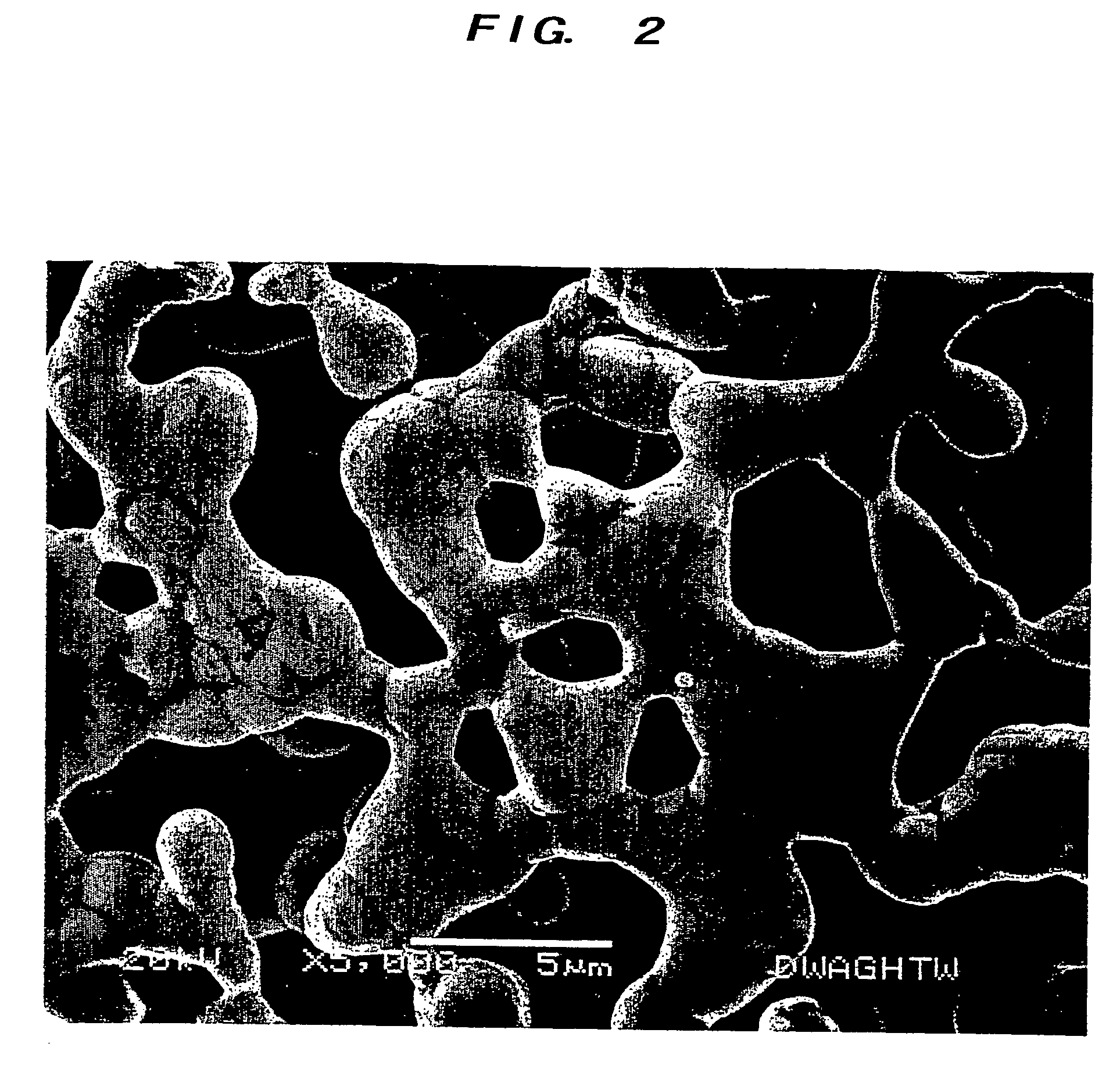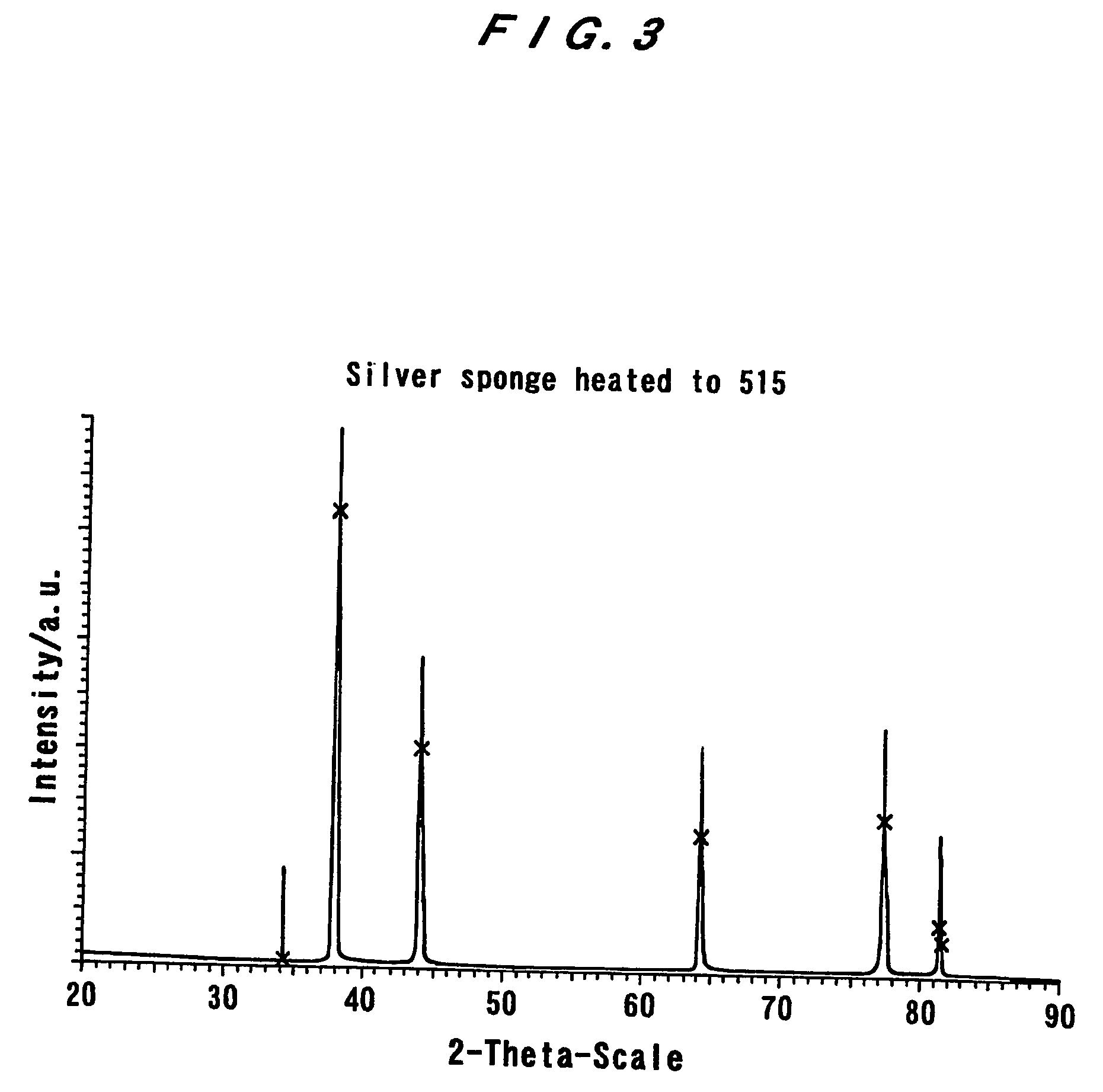Metal or metal oxide porous material prepared by use of dextran or related soluble carbohydrate polymer
- Summary
- Abstract
- Description
- Claims
- Application Information
AI Technical Summary
Benefits of technology
Problems solved by technology
Method used
Image
Examples
example
Example 1
[0049] To distilled water of 20% by weight were mixed dextran (average molecular weight: 70,000) of 38% by weight and silver nitrate of 42% by weight to prepare an aqueous viscous solution. This was poured into a mold and solidified at a room temperature of 25° C. within 20 minutes. Next, the resulting solid matter was heated and baked at a temperature of not less than 500° C.
[0050] Thus, as shown in SEM micrographs: FIGS. 1 and 2, a sponge-shaped silver porous material having communicating pores was obtained. The material had a rod-shaped crystal, and its maximum external dimension of a cross-section perpendicular to the length direction was 4 μm.
[0051]FIG. 3 shows an X-ray diffraction of silver porous material at a temperature o 515° C. FIG. 4 shows the thermo gravimetric analysis data above-mentioned.
[0052] Replication of this procedure using a baking temperature of 600, 700, 800 and 900° C., as shown in FIGS. 5a-5d, produce sponge materials of increased crystal rod ...
example 2
[0053] To distilled water of 20% by weight were mixed dextran (average molecular weight: 70,000) of 38% by weight, silver nitrate of 38% by weight and copper nitrate 4% by weight to prepare an aqueous viscous solution. This was poured into a mold and solidified at a room temperature of 25° C. within 1 hour. Next, the resulting solid matter was heated and baked at a temperature of not less than 900° C.
[0054] Thus, as shown in SEM micrographs: FIGS. 6 and 7, a sponge-shaped gray / silver porous material having communicating pores was obtained. The material had a rod-shaped crystal, and its maximum external dimension of a cross-section perpendicular to the length direction was 50 μm. In addition, as shown in FIGS. 7-10, roughly spherical particles of copper oxide of diameter not exceeding 4 μm are evenly distributed throughout the material and at its surface. FIG. 8 shows an elemental X-ray analysis of a silver and copper oxide sponge formed by heating at 900° C.
[0055]FIG. 9 shows an e...
example 3
[0057] To distilled water of 20% by weight were mixed dextran (average molecular weight: 70,000) of 40% by weight, silver nitrate of 39.855% by weight and titania particles (colloidal anatase titanium dioxide of average diameter 100 nm) 0.145% by weight to prepare an aqueous viscous solution. This was poured into a mold and solidified at a room temperature of 25° C. within 1 hour. Next, the resulting solid matter was heated and baked at a temperature of not less than 600° C.
[0058] Thus, a sponge-shaped gray / silver porous material having communicating pores was obtained. FIG. 11(a) shows a SEM micrograph of silver and titania sponge material following baking at 600° C. FIG. 11(c) shows the micrograph of at higher magnification. The material had a rod-shaped crystal, and its maximum external dimension of a cross-section perpendicular to the length direction was 4 μm, but more typically 1-2 μm. FIG. 12 shows an elemental X-ray analysis of silver and titania sponge formed y heating at ...
PUM
| Property | Measurement | Unit |
|---|---|---|
| Temperature | aaaaa | aaaaa |
| Temperature | aaaaa | aaaaa |
| Percent by mass | aaaaa | aaaaa |
Abstract
Description
Claims
Application Information
 Login to view more
Login to view more - R&D Engineer
- R&D Manager
- IP Professional
- Industry Leading Data Capabilities
- Powerful AI technology
- Patent DNA Extraction
Browse by: Latest US Patents, China's latest patents, Technical Efficacy Thesaurus, Application Domain, Technology Topic.
© 2024 PatSnap. All rights reserved.Legal|Privacy policy|Modern Slavery Act Transparency Statement|Sitemap



